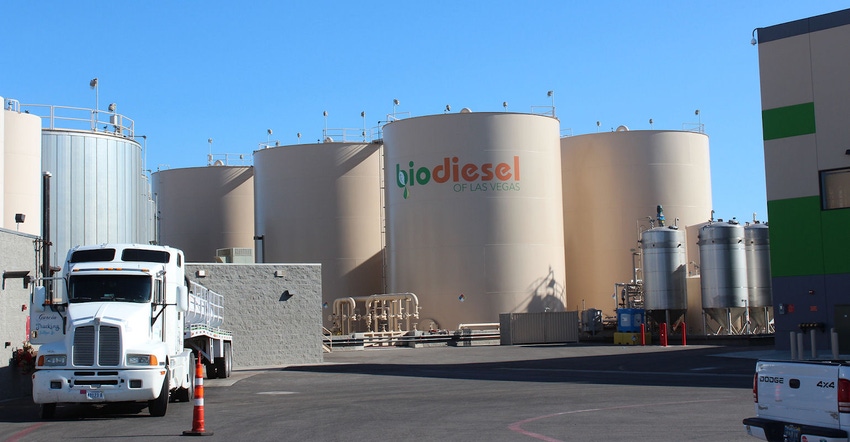Biodiesel demand would drop by 100-300 million gal. per year under proposed RIN cap.

In recent weeks, talk of capping renewable identification numbers (RINs) has picked up as Sen. Ted Cruz (R., Texas) pushed for such a proposal in his discussions with President Donald Trump and senators from biofuel states. The White House has scheduled a meeting for March 12, where it is expected that the fate of the Renewable Fuel Standard (RFS) will be decided.
Several other studies were released over the week, including one from Iowa State University's Center for Agricultural & Rural Development, another one from Purdue University and now one on the impact to the biodiesel market.
A new analysis by the National Biodiesel Board (NBB) and the World Agricultural Economic & Environmental Services (WAEES) found that capping the price of RINs for conventional biofuels will significantly harm the production of biodiesel and related industries. Although some believe that limiting the price of RINs for conventional biofuels won’t harm biomass-based diesel volumes, the analysis offers additional insight detailing that a price cap on conventional ethanol RINs would result in lower volumes of biomass-based diesel produced and used in the U.S.
The analysis found that capping the price of conventional ethanol RINs would lead to a reduction of up to 300 million gal. in biomass-based diesel volumes each year, in part because these volumes would no longer be utilized for compliance with the conventional biofuel requirements.
It also would create $185 million more in feed costs for livestock producers — likely leading to an increase in food costs for consumers.
NBB vice president of federal affairs Kurt Kovarik said, “Capping the price of conventional ethanol RINs would devastate the biodiesel industry — swiftly and significantly — reducing the amount of volumes produced and people employed. Satisfying the whims of fewer than five refiners isn’t worth the resulting harm to millions of workers in U.S. agriculture and livestock production, as well as American consumers. President Trump can sniff out a good deal from a bogus one, and we are hopeful that he will stick with his campaign promise and reject a cap on RIN prices.”
The analysis utilized WAEES’s partial equilibrium model, which can be broken down into crop, livestock and biofuel components encompassing feed grains, food grains, cotton, sugar, oilseeds, ethanol, biodiesel, beef, pork and poultry. Important to understanding the results of the analysis, the model made conservative assumptions, including an assumption that the biodiesel tax credit would be reinstated. If the credit isn’t reinstated, even greater harm and lower domestic production volumes can be expected.
The analysis showed that soybean producers would receive approximately 16 cents/bu. less in 2020 due to reduced demand for their products. On the flip side, the price of soybean meal — i.e., the protein, not the oil for biodiesel production — will increase more than $5 per ton. As a result, livestock producers are expected to pay roughly $185 million more in feed costs due to a cap on RINs. A similar impact can be expected for other oilseed meals, such as canola. These increased costs may negatively affect consumer food costs.
“This analysis clearly demonstrates the severe harm to the biodiesel market caused by capping conventional ethanol RIN prices,” Kovarik said. “The impacts of a RIN cap also extend far beyond energy markets — harming livestock and oilseed producers and raising the cost of food for consumers.”
The RFS — a bipartisan policy passed in 2005 and signed into law by President George W. Bush — requires certain volumes of renewable fuels to be used in transportation fuel, heating oil or jet fuel. Expanded in 2007, the law requires increasing volumes of advanced biofuels, such as biomass-based diesel, with each year.
Advanced biofuels are fuels designated by the U.S. Environmental Protection Agency for meeting the threshold of reducing greenhouse gas emissions by at least 50% compared to petroleum. (Biodiesel has anywhere from 57% to 122% life-cycle greenhouse gas emission reductions compared to petroleum diesel.) Biomass-based diesel and cellulosic biofuels are fuels nested within the advanced biofuel category and can quality both as their nested fuel type and as an advanced biofuel. Advanced biofuels can qualify for RINs for their advanced biofuel category, as well as conventional biofuels (which have a lower threshold of greenhouse gas emission reductions). The interconnected nature of the program and how RINs can qualify for multiple categories is one reason why capping one type of RINs has an impact on other fuels.
About the Author(s)
You May Also Like



.png?width=300&auto=webp&quality=80&disable=upscale)

